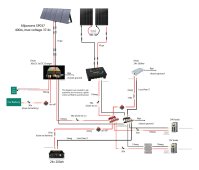0truck0
New Member
I advise people when getting into the rv lifestyle, to consider becoming an RVer and learn the ways of the force, I mean the ways of camping and RVing. Propane is a wonderful thing, lots of energy stored in the bottle, and though it cost every fillup, there is no up-front cost like on batteries, and appliance can last decades.
Diesel fuel can be used for stoves and heat safely.
GIant fridges and freeezers and high wattage household cookers on a small battery platform? This is not ideal. Great for big rigs with permanent and big solar arrays, yes, electric cooking is way easy, but only if you have the batteries. Seems crazy to do this on folding solar. And, no, that 500watts is not going to cut it.
Did you calculate inverter losses?
Alternators are not magic. You van will not have that much extra available amps to just throw at your dead batteries, and you can easily burn out an alternator using it like this. 60amp DC-DC is way way too much amperage draw on your alternator.
Put a bigger alternator, and Im not sure what the biggest you can fit in your van is, but you can do custom also, but this will also be a power drain on your driving motor and affect mpg's (might not care).
If you have future plans, then do that in the future. It is wise to plan ahead, but in this instance is not the right route.
Sounds like you might be better off buying a small inverter generator (gas generator) and just using that to power your big appliances for 6 hours. IF you plan to live off-grid in future then you will have to have a generator anyway, everyone seems to have a generator, invest in generator as your future.
You will just not be running residential freezers and fridges off your folding panels, and definitely not off your alternator.
Do look heavily at the DC powered fridge/freezers, and DO add extra insulation to them to reduce runtime.
Do look at DC only appliances.
Do consider that you will have to make changes when off the grid.
Diesel fuel can be used for stoves and heat safely.
GIant fridges and freeezers and high wattage household cookers on a small battery platform? This is not ideal. Great for big rigs with permanent and big solar arrays, yes, electric cooking is way easy, but only if you have the batteries. Seems crazy to do this on folding solar. And, no, that 500watts is not going to cut it.
Did you calculate inverter losses?
Alternators are not magic. You van will not have that much extra available amps to just throw at your dead batteries, and you can easily burn out an alternator using it like this. 60amp DC-DC is way way too much amperage draw on your alternator.
Put a bigger alternator, and Im not sure what the biggest you can fit in your van is, but you can do custom also, but this will also be a power drain on your driving motor and affect mpg's (might not care).
If you have future plans, then do that in the future. It is wise to plan ahead, but in this instance is not the right route.
Sounds like you might be better off buying a small inverter generator (gas generator) and just using that to power your big appliances for 6 hours. IF you plan to live off-grid in future then you will have to have a generator anyway, everyone seems to have a generator, invest in generator as your future.
You will just not be running residential freezers and fridges off your folding panels, and definitely not off your alternator.
Do look heavily at the DC powered fridge/freezers, and DO add extra insulation to them to reduce runtime.
Do look at DC only appliances.
Do consider that you will have to make changes when off the grid.



